NCERT Solutions for Class 10 Science Chapter 10 Light Reflection and Refraction
These Solutions are part of NCERT Solutions for Class 10 Science. Here we have given NCERT Solutions for Class 10 Science Chapter 10 Light Reflection and Refraction. Learn Insta provides you the Free PDF download of NCERT Solutions for Class 10 Science (Physics) Chapter 10 – Light Reflection and Refraction solved by Expert Teachers as per NCERT (CBSE) Book guidelines. All Chapter 10 – Light Reflection and Refraction Exercise Questions with Solutions to help you to revise complete Syllabus and Score More marks.
NCERT Questions
In Text Book Questions
Question 1.
Define the principal focus of a concave mirror.
Answer:
A point on the principal axis where the parallel rays of light after reflecting from a concave mirror meet.
More Resources
- NCERT Solutions for Class 10 Science
- NCERT Exemplar Solutions for Class 10 Science
- HOTS Questions for Class 10 Science
- Value Based Questions in Science for Class 10
- Previous Year Question Papers for CBSE Class 10 Science
Question 2.
The radius of curvature of a spherical mirror is 20 cm. What is focal length ? (Bihar Board 2012)
Answer:
Radius of curvature, R= 20 cm.

Question 3.
Name a mirror that can give an erect and magnified image of an object.
Answer:
A concave mirror.
Question 4.
Why do we prefer a convex mirror as a rear-view mirror in vehicles ?
[CBSE (All India) 2007, 2011, 2012]
Answer:
This is because a convex mirror forms an erect and diminished (small in size) images of the objects behind the vehicle and hence the field of view behind the vehicle is increased.
Question 5.
Find the focal length of a convex mirror whose radius of curvature is 32 cm.
Answer:
R = +32 cm. Therefore, f = R/2 = +32/2 = +16 cm.
Thus, focal length of the convex mirror = +16 cm.
Question 6.
A concave mirror produces three times magnified (enlarged) real image of an object placed at 10 cm in front of it. Where is the image located ?
Answer:
m – -3, But m = -v/u, so v = 3u
u = -10 cm
v = 3 (-10 cm) =-30 cm
Thus, the image is located at a distance of 30 cm to the left side of the concave mirror.
Question 7.
A ray of light travelling in air enters obliquely into water. Does the light ray bend towards the normal or away from the normal ? Why ?
Answer:
The ray of light bends towards the normal because the speed of light decreases when it goes from air (rarer medium) into water (denser medium).
Question 8.
Light enters from air to glass having refractive index 1.50. What is the speed of light in the glass ? The speed of light in vacuum is 3 x 108 m s-1 (CBSE 2011)
Answer:

Question 9.
You are given kerosene, turpentine and water. In which of these does the light travel faster ?
Answer:
We know, v = c/n. Refractive index (n) of water is 1.333, whereas refractive index of kerosene is 1.44 and that of turpentine is 1.47. As refractive index of water is least, so speed of light in water is more than in kerosene and turpentine. Hence, light travels faster in water.
Question 10.
The refractive index of diamond is 2.42. What is the meaning of this statement ? [CBSE (Delhi) 2008, 2012, 2013; Bihar Board 2012]
Answer:

Question 11.
Define 1 dioptre of power of a lens.
Answer:
Power = I/f (in m).
Power of a lens is 1 dioptre if focal length of the lens is 1 metre or 100 cm.
Question 12.
A convex lens forms a real and inverted image of a needle at a distance of 50 cm from it. Where is the needle placed in front of the convex lens if the image is equal to the size of the object ? Also, find the power of the lens.
Answer:

Question 13.
Find the power of concave lens of focal length 2m?
Answer:

NCERT Chapter End Exercises
Question 1.
Which one of the following materials cannot be tised to make a lens 1
(a) water
(b) glass
(c) plastic
(d) clay.
Answer:
(d). This is because clay is opaque (i.e. light cannot pass through it).
Question 2.
The image formed by a concave mirror is observed to be virtual, erect and larger than the object. Where should be the position of the object ?
(a) between the principal focus and the centre of curvature
(b) at the centre of curvature
(c) beyond the centre of curvature
(d) between the pole of the mirror and its principal focus.
Answer:
(d).
Question 3.
Where should an object be placed in front of a convex lens to get a real image of the size of the object ? (Bihar Board 2012)
(a) at the principal focus of the lens
(b) at twice the focal length
(c) at infinity
(d) between the optical centre of the lens and its principal focus.
Answer:
(b).
Question 4.
A spherical mirror and a thin spherical lens have each a focal length of — 15 cm. The mirror and the lens are likely to be
(a) both are concave
(b) both are convex
(c) the mirror is concave and the lens is convex
(d) the mirror is convex but the lens is concave.
Answer:
(a).
Question 5.
No matter how far you stand from a mirror, your image appears erect. The mirror is likely to be
(a) plane only
(b) concave only
(c) convex only
(d) either plane or convex.
Answer:
(d).
Question 6.
Which of the following lenses would you prefer to use while reading small letters found in a dictionary ?
(a) a convex lens of focal length 50 cm
(b) a concave lens of focal length 50 cm
(c) a convex lens of focal length 5 cm
(d) a concave lens of focal length 5 cm.
Answer:
(c). Magnifying power of a reading glass (Convex lens) = 1/f.
Question 7.
We wish to obtain an erect image of an object, using a concave mirror of focal length 15 cm. What should be the range of distance of the object from the mirror ? What is the nature of the image ? Is the image larger or smaller than the object ? Draw a ray diagram to show the image formation in this case.
Answer:
A concave mirror produces an erect image if the object is placed between the pole and the focus of the concave mirror. Thus, object may be placed at any position whose distance is less than 15 cm from the concave mirror. The image is virtual and erect. The image is larger than the object. For a ray diagram, see figure 24.
Question 8.
Name the type of mirror used in the following situations :
(a) head lights of a car
(b) side rear view mirror of a vehicle
(c) solar furnace.
Support your answer with reason. (CBSE 2012, 2013)
Answer:
(a) Concave mirror. When a bulb is placed at the focus of a concave mirror, then the beam of light from the bulb after reflection from the concave mirror goes as a parallel beam which lights up the front road.
(b) Convex mirror. Image formed by a convex mirror is erect and small in size. The field of view behind the vehicle is large.
(c) Concave mirror. Concave mirror focuses rays of light coming from the sun at its focus. So, the temperature at the focus is raised.
Question 9.
One-half of a convex lens is covered with a black paper. Will this lens produce a complete image of the object ?
(CBSE 2015)
Answer:
A complete image of the object is formed as shown in figure.
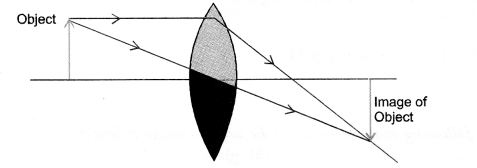
Question 10.
An object 5 cm in length is held 25 cm away from a converging lens of focal length 10 cm. Draw the ray diagram and find the position, size and the nature of the image formed.
Image is real and inverted.
Answer:

Here, u = -25 m, f = 10 m
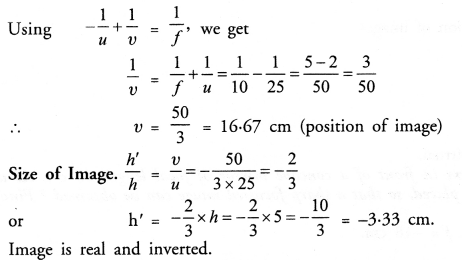
Question 11.
A concave lens of focal length 15 cm forms an image 10 cm from the lens. Hou> far is the object placed from the lens ? Draw the ray diagram.
Answer:

Question 12.
An object is placed at a distance of 10 cm from a convex mirror of focal length 15 cm. Find the position and nature of the image. (CBSE 2014)
Answer:
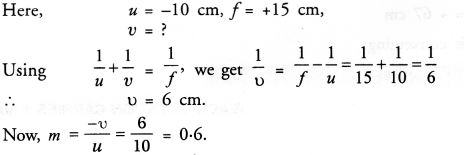
Since, m is positive, so the orientation of both object and image is same. Thus,image is erect and virtual.
Question 13.
The magnification produced by a plane mirror is +1. What does this mean ? (CBSE 2011, 2014)
Answer:
![]()
It means, size of the image formed by plane mirror is equal to the size of the object. Positive sign with m tells that both object and image are erect.
Question 14.
An object 5.0 cm in length is placed at a distance of 20 cm in front of a convex mirror of radius of curvature 30 cm. Find the position of the image, its nature and size. (Similar CBSE 2011)
Answer:
h = 5 cm, u = -20 cm


Since h’ is positive, so image is erect and virtual.
Question 15.
An object of size 7.0 cm is placed at 27 cm in front of a concave mirror of focal length 18 cm. At what distance from the mirror should a screen be placed, so that a sharp focussed image can be obtained ? Find the size and the nature of the image.
Answer:

Since h’ is negative, so image is inverted.
Question 16.
Find the focal length of a lens of power -2.0 D. What type of lens is this ?
Answer:

The lens is concave.
Question 17.
A doctor has prescribed a corrective lens of power +1.5 D. Find the focal length of the lens. Is the prescribed lens diverging or converging ? (CBSE 2012)
Answer:
![]()
Since focal length is positive, so the lens is converging.
Practical Skills Based Questions (2 Marks)
Question 1.
A 4 cm tall object is placed on the principal axis of a convex lens. The distance of the object from the optical centre of the lens is 12 cm and its sharp image is formed at a distance of 24 cm from it on a screen on the other side of the lens. If the object is now moved a little away from the lens, in which way (towards the lens or away from the lens) will he have to move the screen to get a sharp image of the object on it again ? How will the magnification of the image be affected ? (CBSE 2015)
Answer:

When distance of object u increases, V must decrease so that focal length of the lens remains the same. Thus, screen on which sharp image of object is formed is moved towards the lens.
As the distance of object u increases, the size of the image decreases. Hence, magnification of the imag decreases.

As u increases, v decreases and hence m also decreases.
Question 2.
In the given incomplete ray diagram for image A’B’ of a convex lens, what is the position of object AB ? Also complete the ray of diagram? (CBSE 2015)

Answer:
The position of object AB is between F1 and 2F1
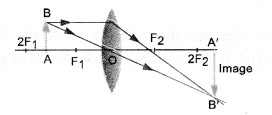
Question 3.
To find the image-distance for varying object-distances in case of a convex lens, a student obtains on a screen a sharp image of a bright object placed very far from the lens. After that he gradually moves the object towards the lens and each time focuses its image on the screen.
(a) In which direction towards or away from the lens, does he move the screen to focus the object ?
(b) What happens to the size of image does it increase or decrease ?
(c) What happens when he moves the object very close to the lens ?
Answer:
![]()
As distance of object decreases, distance of image V must increase so that focal length of lens remains the same. Therefore, the screen must be moved away from the lens.
![]()
As u decreases, v increases, therefore, magnification increases. In other words, size of the image increases.
(c) When object is very close to convex lens, virtual and magnified image is formed.
Question 4.
A student performed an experiment for the image formation by a convex lens at different positions of an object. If focal length of lens is 15 cm
Answer:
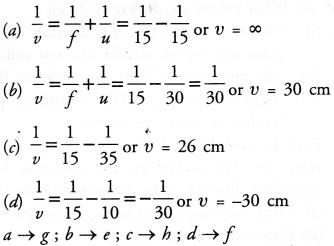
Question 5.
A student performed an experiment with convex lens and found the virtual image of an object. Find :
(a) position of the object.
(b) draw ray diagram for the above situation.
(CBSE 2015)
Answer:
(a) A convex lens forms a virtual image if the object lies between the optical centre and focus- of the convex lens. That is, the distance of the object from the less must be less than the focal length of the lens.
(b)

Question 6.
A student focuses the image of a candle flame, placed at about 2 m from a convex lens of focal length 10 cm, on a screen. After that he moves gradually the flame towards the lens and each time focuses its image on the screen.
(A) In which direction does he move the lens to focus the flame on the screen 1
(BJ What happens to the size of the image of the a formed on the screen 1
(C) What difference is seen in the intensity (brightness) of the image of the a screen ?
(D) What is seen on the screen when the flame is very close (at about 5 cm) to the lens ? (CBSE 2017)
Answer:

As the distance of the candle flame (object) u decreases, distance of image u must increase so that the focal length of the lens remains the same. Therefore, the screen must be moved away from the lens.
![]()
As u decreases, v increases therefore, magnification increases, other words, size of the image increases.
(C) As the size of the image increases, so the intensity (brightness) of the image of the flame on the screen decreases.
(D) When the flame is at about 5 cm, which is less than the focal length (10 cm) of the lens.
In this case, magnified, erect and virtual image of the flame is formed. Since, virtual image cannot be obtained on the screen, so nothing is seen on the screen.
Question 7.
A student places a candle flame at a distance of about 60 cm from a convex lens of focal length 10 cm and focuses the image of the flame on a screen. After that he gradually moves the flame towards the lens and each time focuses the image on the screen.
(A) In which direction-toward or away from the lens, does he move the screen to focus the image ?
(B) How does the size of the image change ?
(C) How does the intensity of the image change as the flame moves towards the lens ?
(D) Approximately for what distance between the flame and the lens, the, image formed on the screen is inverted and of the same size ? (CBSE 2017)
Answer:

As the distance of the candle flame (object) u decreases, distance of image u must increase so that the focal length of the lens remains the same. Therefore, the screen must be moved away from the lens.
![]()
As u decreases, v increases therefore, magnification increases, other words, size of the image increases.
(C) As the size of the image increases, so the intensity (brightness) of the image of the flame on the screen decreases.
(D) When object is placed at 2F, a real and inverted image of same size as that of the object is formed at 2F on the other side of the lens. Therefore, in this case, the distance between flame and the lens is approximately 20 cm so that the image formed on the screen is inverted and of the same size.
NCERT Solutions for Class 10 Science Chapter 10 Light Reflection and Refraction
Hope given NCERT Solutions for Class 10 Science Chapter 10 are helpful to complete your science homework.
If you have any doubts, please comment below. Learn Insta try to provide online science tutoring for you.